Fat Chance
By Mary Jacobs
Photo illustration by Marc and Melanie Chartrand
People who recite the Boy Scout Oath promise to keep themselves ‘physically strong.’ That goes for adult leaders, too. It’s time for you and your Scouts to get fitter and faster—and avoid missing out on Scouting’s greatest adventures.
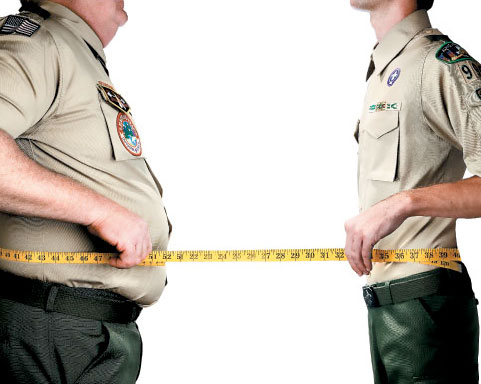 |
What Bob Shanahan saw troubled him. The Scoutmaster of Troop 121 in Clinton, N.J., led “modest hikes” of about three miles, with short, gentle climbs. Shanahan, 50, and not particularly athletic, easily handled the hikes. The Scouts, however, couldn’t keep up. Many were overweight.
“The kids would ask me, ‘Mr. Shanahan, can we stop now?’” he says. “They were out of breath. It scared the you-know-what out of me.”
Shanahan’s not the only one who’s frightened.
Overweight, out-of-shape kids in the United States represent a problem of epidemic proportions, one that threatens to create a public-health crisis in the years ahead. And Scouting’s not exempt.
“In my travels, I see many bright, smiling faces,” reports Chief Scout Executive Robert J. Mazzuca. “But all too often, I also see evidence of unhealthy lifestyles among our young people.”
Unfortunately, youth and leaders in Scouting are every bit as overweight as the rest of the population—if not more so, says Ruth T. Reynolds RN, BSN, and medical coordinator for the Boy Scouts of America.
Body-mass index (BMI) data collected from applicants for the 2010 National Scout Jamboree show that 41 percent of the youth were overweight or obese; among the adults, a staggering 77.5 percent were overweight, obese, or morbidly obese. But Scouting is determined to raise the bar by encouraging responsibility.
The Annual Health and Medical Record, which takes effect in January 2010, restricts participation in high-adventure activities based on standardized height/weight ratios. For wilderness outings where health care is 30 minutes or more away, Scouts deemed too overweight won’t be allowed to participate. And bottom line: If you’re overweight, you can’t attend Philmont Scout Ranch, Florida Sea Base, or Northern Tier High Adventure Base.
Reynolds doesn’t apologize for that. She says the BSA intends the new forms to be in line with the Scout Oath: “I will keep myself physically strong, mentally awake, and morally straight.” She argues that, “We as Scouters are not taking responsibility for who we are. The Scout Law says a Scout has 12 important characteristics, but it doesn’t say a Scout is sedentary, fat, or unhealthy.”
Leaders say Scouting must confront the issue of obesity, the biggest health threat facing children today, as part of its commitment to child advocacy.
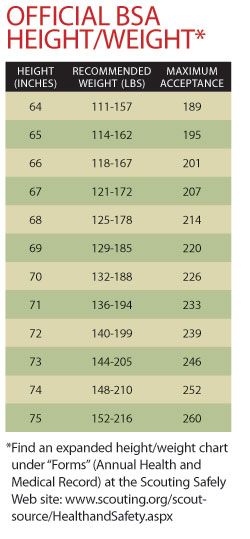 “Our role is clear,” Mazzuca says, “We must continue to aggressively create and promote programs that help build healthier lifestyles for our Scouts. As leaders, we must do all we can to set the example for encouraging these healthy choices, not only for our Scouts, but for their parents and peers as well. Their future is Scouting’s future.”
“Our role is clear,” Mazzuca says, “We must continue to aggressively create and promote programs that help build healthier lifestyles for our Scouts. As leaders, we must do all we can to set the example for encouraging these healthy choices, not only for our Scouts, but for their parents and peers as well. Their future is Scouting’s future.”
OBESITY RATES HAVE soared in all age groups over the past three decades. They’ve doubled among children and tripled among adolescents. And nearly one in three young Americans is overweight or obese. All of which foretells a sobering future.
“If we don’t succeed in reversing this epidemic,” according to a report by the Robert Wood Johnson Foundation, “we are in danger of raising the first generation of American children who will live sicker and die younger than their parents’ generation.”
In addition, the costs of medical care for obesity-related disease and the resulting loss in productivity could be staggering. The obesity epidemic already costs our nation $117 billion annually in medical expenses, as well as lost productivity. Childhood obesity alone costs up to $14 billion annually, and if trends continue, that number will only get worse.
“I think it’s literally going to overwhelm us,” says Dr. Sandra Hassink, who heads a youth-obesity clinic in Wilmington, Del., and chairs the obesity leadership group for the American Academy of Pediatrics.
Authorities also say obesity affects a child’s quality of life. Obese kids have negative body images and poor self-esteem. Many become targets for bullying. And obesity threatens a child’s health—both in the short and long term. Overweight kids suffer greater risks for diabetes, heart disease, asthma, sleep apnea, depression, and other problems.
“Think of obesity as an accelerator for disease,” Dr. Hassink says. “Until recently, we called Type 2 diabetes ‘adult onset’ because we never saw it in children. Now, it’s showing up in kids as young as 12.”
ACTIVITY INCREASES IN KIDS when they get outdoors. But Richard Louv, author of Last Child in the Woods, thinks the outdoors could fight obesity beyond just burning calories.
A lack of exposure to nature, Louv says, affects people in deep ways—not yet understood—that could account for some of the underlying psychological causes behind overeating and inactivity. He calls it “nature deficit disorder,” and obesity, he thinks, is one of its symptoms.
Dr. Hassink, who was a Cub Scout den leader when her children were young, believes the Scouting program can perform a critical service in tackling obesity. “It’s perfectly positioned,” she says. “It’s an outlet for children of all backgrounds and abilities to become more physically active.”
Louv echoes what many Scout leaders assert: Outdoor activities—camping, hiking, canoeing, and other adventures—represent Scouting’s best hope for fighting the obesity epidemic.
“Those activities drive Scouts to want to become fit, lose the game controller, and get on a bike to get in shape,” says Alex Zic, an Eagle Scout and assistant Scoutmaster for Troop 162 in the Bronx, N.Y. And outdoor activities can serve as a recruiting selling point, too, as parents grow more aware—and more worried—about the obesity epidemic.
That’s why many parents found ways to take a visible leadership role in the community. Jason Barlow, area commissioner for the Northeast Region, uses public service announcements aired on local radio stations as an answer to obesity:
“Our kids are spending too much time indoors, online, and logged on to the computer. At Scout camp ‘logged on’ means putting more wood on the campfire and ‘online’ means catching a great trout for dinner. Scouting will get your son unplugged from screen time and plugged into the great outdoors, where he will develop character and leadership skills.”
Recently, the council teamed with the Girl Scouts for a “No Child Left Inside” day hike. Promotions pitched Scouting as an antidote for sedentary kids. “The Boy Scouts are all about character and the outdoors,” says Diego Aviles, chief operating officer for the Hudson Valley Council. “It’s only natural to position Scouting as the remedy to youth obesity.”
Similarly, the Northern Star Council, headquartered in Minneapolis-St. Paul, Minn., partnered with a local TV station to sponsor a series of “Keep Movin’” events promoting fitness. Scouts and Venturers served as staff and volunteer instructors for a variety of winter outdoor activities at a local arena and ski area. And Audun Mikkelson issued a “Scout Executive’s Challenge” to each pack, troop, team, and crew in the Great Alaska Council.
Starting in January 2009, participating Scouts in the Alaska council began getting “outside and active” for 13 consecutive monthly activities in pursuit of the “2010 Scout Executive’s Active Outdoor Challenge” patch. Qualifying activities include “anything that gets your boys outdoors and moving under their own power”: biking, skiing, canoeing, climbing, rollerblading, soccer, swimming, or backpacking.
Troop 121’s Shanahan issued his own “Scoutmaster Challenge” to the unit’s patrols, urging them to hike 50 miles in six months and earn a “50 Miler” patch. He encourages his troop leaders to take a leadership role, too. “I say, ‘You know the guys who can’t keep up. So let’s talk to those guys, see if we can build up their endurance a little bit.’
“I realized we’ve got to get those guys out of their houses,” he says.
AND IF YOU GRIPE about the new health forms that require annual physicals, Jack Haycock doesn’t want to hear it.
In 2002, Haycock’s doctor refused to approve his physical to attend Scout camp. He was overweight, his blood pressure was sky high, and his blood sugar had slipped into diabetic range. The rejection spurred Haycock to exercise and healthier eating habits. He dropped 125 pounds, and kids in his troop noticed.
One night around the campfire, they began bragging about who could do the most push-ups. Haycock managed to eke out a few, and the boys cheered. “I could never have done push-ups when I was fat,” he says, “and they knew it.”
Haycock’s physical in 2005, in advance of the national Scout jamboree, turned up a diagnosis of prostate cancer but in a very early stage. He’s cancer-free now.
So don’t complain about the physicals to Jack Haycock.
“Scouting physicals saved my life—twice!” he says.
Mary Jacobs, a Dallas-based freelance writer, was inspired by nurse Ruth Reynolds to lose 10 pounds while working on this article.
Scouting's By-the-Numbers Guide to Fighting the FlabWe know that getting started is the hardest part, so we present our quick-start guide. Just follow these numbers and you’ll see results as quickly as 1-2-3.
5 WAYS TO DEAL WITH THE KID IN THE BACK
ADD THESE 3 SIMPLE DIET CHANGES AND LOSE SOME POINTS
Google “healthy camping recipes” to find hundreds of ideas for eating healthier on the trail, including:
|
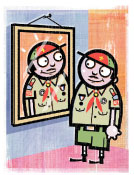 GET WITH THIS 5-STEP PROGRAM
GET WITH THIS 5-STEP PROGRAM Overweight kids pose a challenge for adult leaders as well as young people. On a hike, how can leaders encourage the overweight Scout who is struggling without singling him out? “Don’t underestimate the value of the atmosphere you help create,” says Dr. Sandra Hassink, of the American Academy of Pediatrics. She emphasizes two words: “include” and “empower.”
Overweight kids pose a challenge for adult leaders as well as young people. On a hike, how can leaders encourage the overweight Scout who is struggling without singling him out? “Don’t underestimate the value of the atmosphere you help create,” says Dr. Sandra Hassink, of the American Academy of Pediatrics. She emphasizes two words: “include” and “empower.” 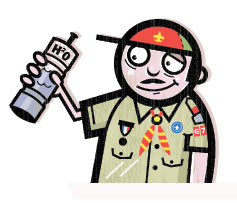 SIX SWAPS SAVE 700+ CALORIES A DAY
SIX SWAPS SAVE 700+ CALORIES A DAY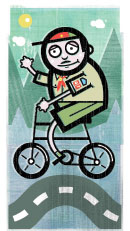 5 STEALTHY WAYS TO SNEAK EXERCISE INTO YOUR DAY
5 STEALTHY WAYS TO SNEAK EXERCISE INTO YOUR DAY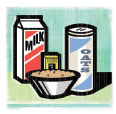 5 CAMP MEALS THAT WON'T GO TO YOUR GUT
5 CAMP MEALS THAT WON'T GO TO YOUR GUT